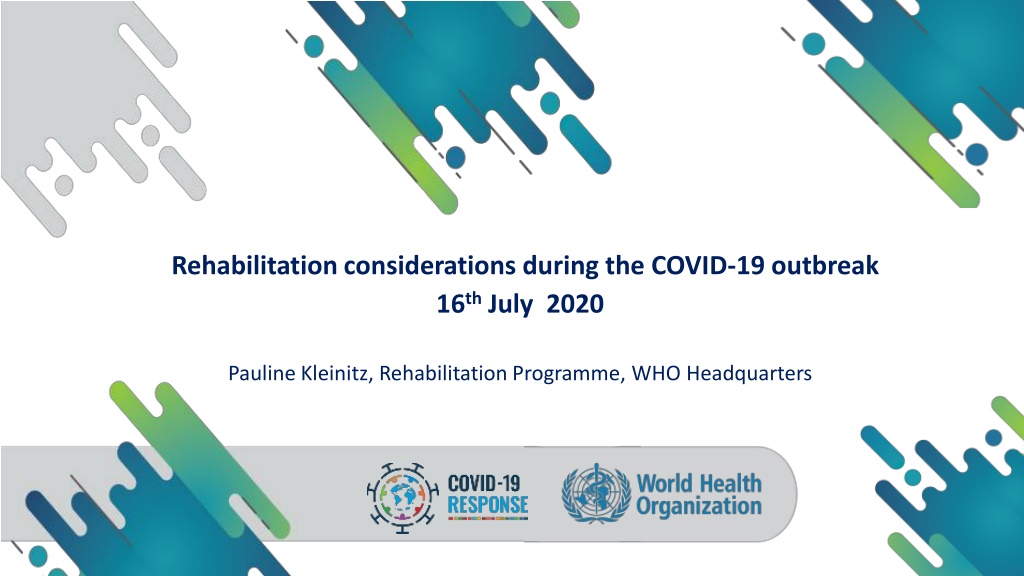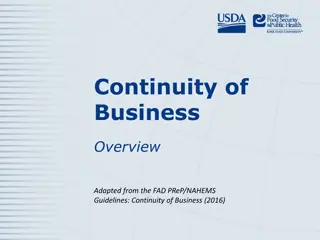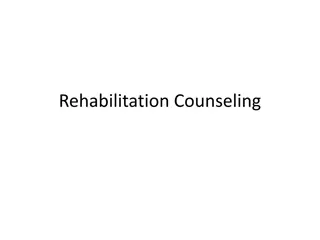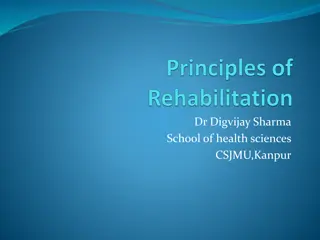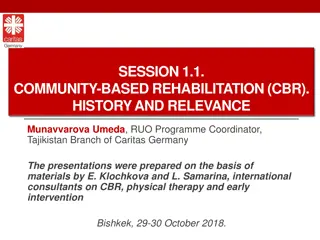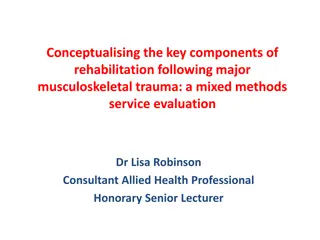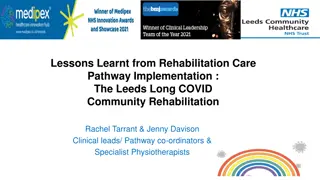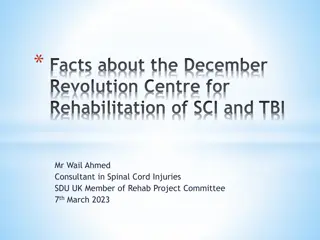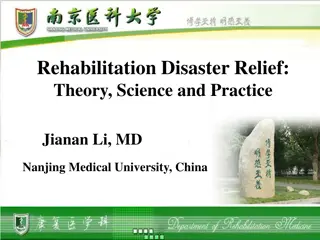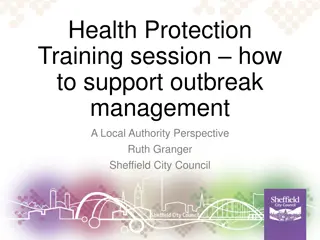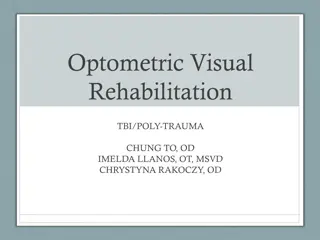Rehabilitation Considerations During the COVID-19 Outbreak
Rehabilitation services during the COVID-19 pandemic are crucial for continuing essential care and optimizing outcomes, especially for individuals with severe COVID-19 cases. Considerations for non-COVID-19 rehabilitation services must be maintained to address acute injuries, post-surgical recovery, long-term care, and safe discharge. Rehabilitation for severe COVID-19 patients focuses on managing complications from respiratory failure and immobilization. The rehabilitation continuum involves identifying impairments, facilitating safe discharge, optimizing oxygenation, managing secretions, and preventing complications across acute, post-acute, and long-term care settings.
Download Presentation

Please find below an Image/Link to download the presentation.
The content on the website is provided AS IS for your information and personal use only. It may not be sold, licensed, or shared on other websites without obtaining consent from the author. Download presentation by click this link. If you encounter any issues during the download, it is possible that the publisher has removed the file from their server.
E N D
Presentation Transcript
Rehabilitation considerations during the COVID-19 outbreak 16thJuly 2020 Pauline Kleinitz, Rehabilitation Programme, WHO Headquarters
Why we need to consider rehabilitation? Impact of COVID-19 on rehabilitation services Rehabilitation in the context of the COVID-19 pandemic is required for: 1. Continuation of rehabilitation services for people with essential needs 2. Rehabilitation for optimizing outcomes of people who experience severe COVID-19 Survey Results of the WHO Rapid Assessment of Continuity of Essential Health Services
Consideration for Continuity of Non-COVID-19 Rehabilitation Services Essential rehabilitation needs continue for: Patients with new acute injuries, such as burns, amputations or spinal cord injuries who may develop serious preventable complications. Patients recovering from surgery. Patients with conditions who are at risk of suboptimal recovery, such as those recovering from stroke, myocardial infarction or perinatal complications. Patient requiring long-term rehabilitation in hospitals, residential centres or community settings who may experience a loss of function or develop complications. Patients who are unable to be discharged to a setting and be safe, or who may return to a setting that is a very long distance from the service and likely preclude them from future access.
Rehabilitation for Severe COVID-19 Severe COVID-19 patients The illness may be complicated by respiratory failure and other forms of multi organ failure, resulting in ICU admission with likely invasive mechanical ventilation. Rehabilitation needs are typically related to the consequences of ventilatory support, and prolonged immobilization
Rehabilitation along the continuum of care in COVID-19 Post-acute Acute Long-term Objectives Objectives Objectives - Identify and manage impairments for affected functioning domains - Facilitate safe discharge and onward referral - Optimize oxygenation - Manage secretions - Prevent complications - Optimize functioning/ minimize impact of impairments on independence and quality of life Input: Specialist Respiratory physiotherapist /therapist and/or rehabilitation staff experienced with ICU/HDU setting Input: Multidisciplinary Input: Multidisciplinary Setting: Rehabilitation ward/unit, stepdown facility, home Setting: Home, outpatient facility, clinic Setting: ICU/HDU
Rehabilitation for severe COVID-19 Impairments most likely to encounter: Physical deconditioning and muscle weakness, fatigue Impaired lung function Delirium and other cognitive impairments Impaired swallow and communication Mental health disorders and psychosocial support needs. Multi-disciplinary team approach is key Still many unknowns related to the pathophysiology of COVID-19 and the long-term complications, many organs can be affected
Common country experiences Rehabilitation services significantly reduced and often without full consideration of the consequences. Decisions made locally regarding continuation of rehabilitation services, limited national direction. Inadequate consideration of all four factors regarding service continuation : I. Risks associated with cessation or reduction of services for different patient groups II. Feasibility and appropriateness of alternative modes of service delivery e.g. telehealth, home outreach III. Access to PPE and robustness of IPC measures in different settings IV. Capacity of the rehabilitation workforce, e.g. available for redistribution COVID-19 related rehabilitation needs increased in tertiary settings and major urban areas, but less new need in rural areas. Generally, reduced demand in line with reductions in elective surgery, transportation, lockdowns etc Where face to face rehabilitation has not been an option a re-purposing workforce towards alternatives like tele-health, advice/help lines and developing self management plans has occurred, as has re-purposing for triage and other urgent needs
Common country experiences PPE for rehabilitation personnel is essential but concerns repeatedly raised about limited access. Unmet rehabilitation needs & lack of resources reported to ministries of health, advocacy by professionals essential, value of involving rehabilitation workforce in service decisions highlighted Telehealth (primarily phone calls) being utilised for service delivery for patients - important way forward Online videos for patient rehabilitation and pre-developed pamphlets used for COVID-19 clients Supply chains for assistive products interrupted Greater task-sharing, upskilling and transdisciplinary teamwork occurring but must be within scope of practice. Rehabilitation professionals undertaking online training Inadequate social support services for people with disabilities repeatedly highlighted as a concern
Rehabilitation sector reflections No perfect response Context vary, teams vary - need to adopt, adapt and evaluate approaches Opportunity to highlight the value of rehabilitation Opportunity to strengthen teams and efficiencies Opportunity to harness telehealth for the long term Importance of social sector support services for people with disabilities, and continuation of health and social sector collaboration Opportunity to learn and link with international groups/ resources / training
Key products Rehabilitation integrated into WHO Products Forthcoming: WHO Community Facilities and Treatment Centres Rehabilitation also being integrated into the WHO s new OpenWHO platform for online courses https://www.who.int/publications/i/item/10665-332240 https://www.who.int/publications/i/item/clinical-management-of-covid-19
Key documents WHO Rehabilitation Documents https://www.euro.who.int/en/health-topics/Life-stages/disability-and- rehabilitation/publications/support-for-rehabilitation-self-management-after-covid-19-related- illness-2020 https://www.paho.org/en/documents/rehabilitation-considerations-during- covid-19-outbreak
Key documents WHO Disability Document https://www.who.int/publications/i/item/WHO-2019-nCoV-Disability-2020-1
